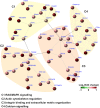RNA sequencing analysis of human podocytes reveals glucocorticoid regulated gene networks targeting non-immune pathways
- PMID: 27774996
- PMCID: PMC5075905
- DOI: 10.1038/srep35671
RNA sequencing analysis of human podocytes reveals glucocorticoid regulated gene networks targeting non-immune pathways
Abstract
Glucocorticoids are steroids that reduce inflammation and are used as immunosuppressive drugs for many diseases. They are also the mainstay for the treatment of minimal change nephropathy (MCN), which is characterised by an absence of inflammation. Their mechanisms of action remain elusive. Evidence suggests that immunomodulatory drugs can directly act on glomerular epithelial cells or 'podocytes', the cell type which is the main target of injury in MCN. To understand the nature of glucocorticoid effects on non-immune cell functions, we generated RNA sequencing data from human podocyte cell lines and identified the genes that are significantly regulated in dexamethasone-treated podocytes compared to vehicle-treated cells. The upregulated genes are of functional relevance to cytoskeleton-related processes, whereas the downregulated genes mostly encode pro-inflammatory cytokines and growth factors. We observed a tendency for dexamethasone-upregulated genes to be downregulated in MCN patients. Integrative analysis revealed gene networks composed of critical signaling pathways that are likely targeted by dexamethasone in podocytes.
Figures




Similar articles
-
α-Actinin-4 is involved in the process by which dexamethasone protects actin cytoskeleton stabilization from adriamycin-induced podocyte injury.Nephrology (Carlton). 2012 Nov;17(8):669-75. doi: 10.1111/j.1440-1797.2012.01645.x. Nephrology (Carlton). 2012. PMID: 22804863
-
Microarray analyses of glucocorticoid and vitamin D3 target genes in differentiating cultured human podocytes.PLoS One. 2013 Apr 4;8(4):e60213. doi: 10.1371/journal.pone.0060213. Print 2013. PLoS One. 2013. PMID: 23593176 Free PMC article.
-
Krüppel-Like Factor 15 Mediates Glucocorticoid-Induced Restoration of Podocyte Differentiation Markers.J Am Soc Nephrol. 2017 Jan;28(1):166-184. doi: 10.1681/ASN.2015060672. Epub 2016 Jun 10. J Am Soc Nephrol. 2017. PMID: 27288011 Free PMC article.
-
The impact of steroids on the injured podocytes in nephrotic syndrome.J Steroid Biochem Mol Biol. 2020 Feb;196:105490. doi: 10.1016/j.jsbmb.2019.105490. Epub 2019 Oct 3. J Steroid Biochem Mol Biol. 2020. PMID: 31586640 Review.
-
Targeting signaling pathways in glomerular diseases.Curr Opin Nephrol Hypertens. 2012 Jul;21(4):417-27. doi: 10.1097/MNH.0b013e328354a598. Curr Opin Nephrol Hypertens. 2012. PMID: 22660552 Review.
Cited by
-
The Use of High-Throughput Transcriptomics to Identify Pathways with Therapeutic Significance in Podocytes.Int J Mol Sci. 2019 Dec 31;21(1):274. doi: 10.3390/ijms21010274. Int J Mol Sci. 2019. PMID: 31906131 Free PMC article.
-
The Role of Glucocorticoid Receptors in Podocytes and Nephrotic Syndrome.Nucl Receptor Res. 2018;5:101323. doi: 10.11131/2018/101323. Epub 2018 Apr 24. Nucl Receptor Res. 2018. PMID: 30417008 Free PMC article.
-
Regulatory Genomic Data Cubism.iScience. 2018 May 25;3:217-225. doi: 10.1016/j.isci.2018.04.017. Epub 2018 Apr 26. iScience. 2018. PMID: 30428322 Free PMC article.
-
How immunosuppressive drugs may directly target podocytes in glomerular diseases.Pediatr Nephrol. 2022 Jul;37(7):1431-1441. doi: 10.1007/s00467-021-05196-4. Epub 2021 Jul 9. Pediatr Nephrol. 2022. PMID: 34244853 Review.
-
Serum Response Factor Is Essential for Maintenance of Podocyte Structure and Function.J Am Soc Nephrol. 2018 Feb;29(2):416-422. doi: 10.1681/ASN.2017050473. Epub 2017 Nov 7. J Am Soc Nephrol. 2018. PMID: 29114040 Free PMC article.
References
-
- Boute N. et al.. NPHS2, encoding the glomerular protein podocin, is mutated in autosomal recessive steroid-resistant nephrotic syndrome. Nat. Genet. 24, 349–354 (2000). - PubMed
-
- Kestilä M. et al.. Positionally cloned gene for a novel glomerular protein–nephrin–is mutated in congenital nephrotic syndrome. Mol. Cell 1, 575–582 (1998). - PubMed
-
- Hinkes B. G. et al.. Nephrotic syndrome in the first year of life: two thirds of cases are caused by mutations in 4 genes (NPHS1, NPHS2, WT1, and LAMB2). Pediatrics 119, e907–e919 (2007). - PubMed
-
- Shih N. Y. et al.. Congenital nephrotic syndrome in mice lacking CD2-associated protein. Science 286, 312–315 (1999). - PubMed
Publication types
MeSH terms
Substances
LinkOut - more resources
Full Text Sources
Other Literature Sources
Medical
Molecular Biology Databases

